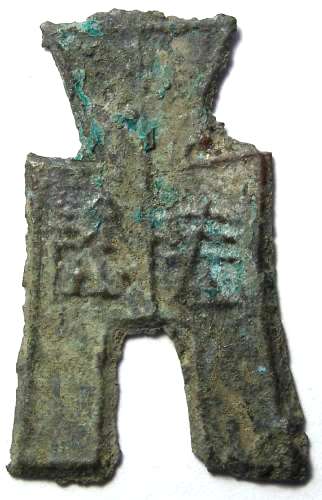
The currency is a medium for the exchange of commodities. It was an inevitable outcome of such exchanges. In ancient China the currency came in different forms and was made variously from shells, jade, gold, silver, and paper.
Brief introduction about variety of ancient coins.
Shell money. Shell money was the oldest form of currency in ancient China. As the shells were small and hard in texture, they came in handy as money. By the Shang (shāng 商) and Zhou (zhōu 周) dynasties the use of shell money reached its top, and shell money became a symbol of wealth.

Hoe-like Money. The hoe-like money was evolved from an ancient Chinese farming toll. In the early days it bore close resemblance to a hoe. Because the hoe is similar to the shovel. This is why the hoe-like money is also known as “shovel money”.
Knife-shaped money. Cast of bronze during the Spring and Autumn and Warring States (chūn qiū zhàn guó 春秋战国) periods, the money’s knife-like shape was derived from a certain weapon from old days.

Bronze money in the design of seashells. With the development of commodity exchange, the supply of natural shells as the currency ran out of supply. Imitation shell money made from stone, bone, ceramics and bronze was thus invented to make up for the shortage. But eventually it was bronze shell-shaped money that replaced natural shells. It was nor until Qinshihuang (qín shǐ huáng 秦始皇) unified the currency in 221 B.C. that shells finally were withdrawn from commodity circulation.

Chinese coins are essential ingredients in the practice of Feng Shui (fēng shuǐ 风水). It is the most potent symbol of wealth, especially when tied with red thread. They are rounded shape with a square hole in the center. The circle represents heaven while the square represents earth. When used by humans, they represent the cosmic trinity of luck of "Heaven-Earth-Man".There is the Yang side (yáng miàn 阳面) (with four chinese characters according to reign of emperor) and the Yin side (yīn miàn 阴面) (2 characters) on every chinese coins. The Yang side should always be used facing up. Feng Shui masters (fēng shuǐ shī 风水师) often focus only on Ching Dynasty coins compared to other dynasties because Ching was the most powerful dynasty in China, while other dynasties usually collapsed in less than a century. The Chinese coins, particularly of those of the Kang Hsi or Chien Long Emperors' reign are deemed most auspicious. Chinese coins are creation of old advisors of emperors and that is why chinese coins are powerful emblems of wealth, endless fortune and prosperity.
The ancient Chinese coins can be seen in the most museum in China. If you have a Shanghai travel, you can see the above-mentioned coins in Shanghai Museum.
No comments:
Post a Comment